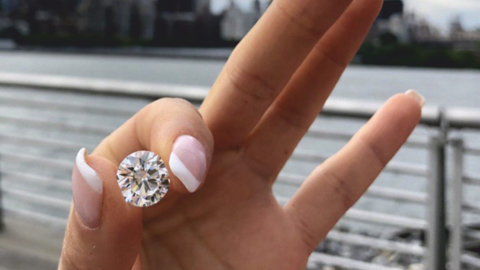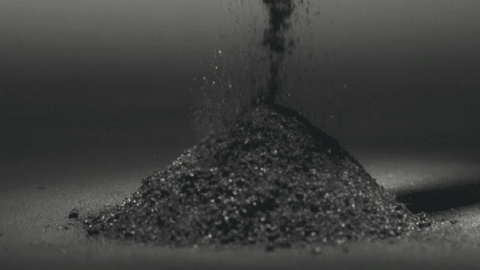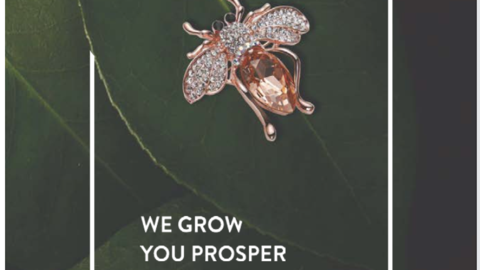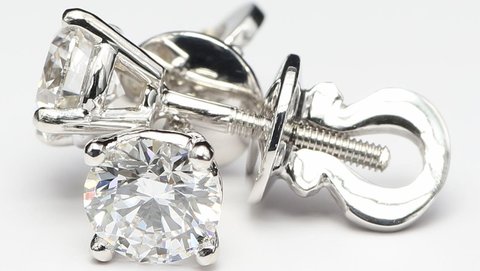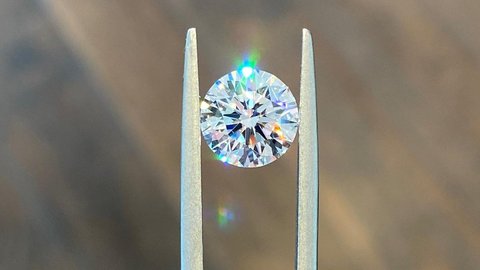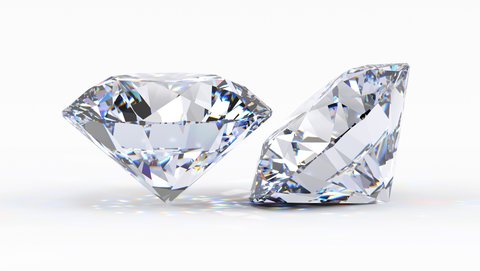SI1 and SI2 Lab-Grown Diamonds
Choosing Between SI1 and SI2 Lab-Grown Diamonds: The Ultimate Guide
When shopping for the perfect lab-grown diamond, clarity is one of the crucial factors that influences both appearance and price. At Labrilliante, we understand that navigating between SI1 and SI2 clarity grades can be challenging for many diamond shoppers. This comprehensive guide will help you understand the key differences between these popular clarity grades, allowing you to make an informed decision that balances beauty and budget when selecting your perfect lab-grown diamond.

Understanding Diamond Clarity: The Foundation of Brilliance
Before diving into the specifics of SI1 and SI2 diamonds, it's important to understand what diamond clarity actually means. Clarity refers to the presence of internal characteristics (inclusions) and external features (blemishes) in a diamond. The Gemological Institute of America (GIA) grades clarity on a scale ranging from Flawless (no inclusions or blemishes visible under 10× magnification) to Included (inclusions visible to the naked eye).
Lab-grown diamonds at Labrilliante follow the same clarity grading system as natural diamonds, with SI1 and SI2 falling in the middle of this scale:
The SI (Slightly Included) category represents diamonds with inclusions that are noticeable under 10× magnification but may or may not be visible to the naked eye. This category offers a good balance between clarity and value, making SI1 and SI2 diamonds popular choices for engagement rings and other fine jewelry.
Exploring SI1 Lab-Grown Diamonds: Premium Clarity with Value
SI1 (Slightly Included 1) diamonds represent the higher tier within the SI clarity category. At Labrilliante, our collection of lab-grown SI1 diamonds offers excellent value while maintaining superior visual appeal.

Characteristic Features of SI1 Lab-Grown Diamonds
SI1 diamonds typically contain inclusions that are easily visible under 10× magnification but are often difficult to see with the naked eye. These inclusions may include:
- Small crystal inclusions
- Minor feathers (tiny cracks)
- Pinpoint clusters
- Needles (thin, elongated crystal inclusions)
The key advantage of SI1 diamonds is that approximately 70-80% of them appear "eye-clean," meaning the inclusions aren't visible without magnification when the diamond is set in jewelry.
Price Range and Value Proposition
At Labrilliante, our lab-grown SI1 diamonds typically offer significant value compared to higher clarity grades. For example, choosing an SI1 diamond over a VS2 can save approximately 10-15% while often maintaining the same visual appearance to the unaided eye.
SI1 diamonds represent an excellent choice for buyers who want a visually clean diamond without paying a premium for technically higher clarity grades that don't necessarily translate to visible differences.
Finding the Perfect SI1 Diamond
When shopping for SI1 lab-grown diamonds at Labrilliante, we recommend:
- Examining the diamond's certificate to understand the nature and location of inclusions
- Viewing the diamond under different lighting conditions
- Checking if inclusions are positioned where they might be hidden by prongs when set
SI2 Lab-Grown Diamonds: Maximizing Value Without Compromising Beauty
SI2 (Slightly Included 2) represents the lower tier of the SI clarity category, offering an excellent opportunity for budget-conscious shoppers at Labrilliante who understand how to select these diamonds wisely.

Defining Characteristics of SI2 Lab-Grown Diamonds
SI2 diamonds contain inclusions that are readily visible under 10× magnification and may sometimes be visible to the naked eye, depending on:
- Size and nature of inclusions
- Location within the diamond
- Diamond cut and proportions
- Viewing angle and lighting conditions
Typical SI2 inclusions may include:
- Larger crystal inclusions
- More noticeable feathers
- Cloud formations (clusters of tiny inclusions)
- Carbon spots
At Labrilliante, approximately 30-50% of our SI2 lab-grown diamonds can be considered "eye-clean," making careful selection particularly important.
Value Assessment and Price Benefits
Our lab-grown SI2 diamonds typically offer remarkable savings of approximately 15-25% compared to SI1 diamonds of similar size and quality. This significant price advantage makes SI2 an attractive option for shoppers looking to maximize carat weight while maintaining a modest budget.
The Art of Selecting a Beautiful SI2 Diamond
The key to finding an exceptional SI2 diamond at Labrilliante lies in strategic selection:
- Focus on diamonds where inclusions are positioned near the edges, where they can be concealed by prongs
- Consider slightly stronger color grades to balance overall appearance
- Prioritize excellent cut quality, as superior light performance can distract from minor clarity issues
- Examine the diamond from multiple angles under different lighting conditions
Comparison of Typical Characteristics: SI1 vs SI2 Lab-Grown Diamonds
| Feature | SI1 Lab-Grown Diamonds | SI2 Lab-Grown Diamonds |
|---|---|---|
| Eye-clean percentage | 70-80% | 30-50% |
| Typical price discount vs VS2 | 10-15% | 25-35% |
| Visibility of inclusions | Rarely visible to naked eye | Sometimes visible to naked eye |
| Best diamond shapes | All shapes suitable | Round, cushion, and radiant hide inclusions better |
| Recommended minimum cut grade | Very Good | Excellent |

SI1 vs SI2: Making the Right Choice for Your Lab-Grown Diamond
When deciding between SI1 and SI2 clarity grades for your lab-grown diamond, understanding the key differences can help you make a choice that aligns with your priorities and budget. At Labrilliante, we help our customers navigate this important decision with expert guidance and transparency.
Visual Comparison: What Your Eyes Can See
The most critical difference between SI1 and SI2 diamonds is the likelihood of visible inclusions.
While both clarity grades contain inclusions visible under magnification, SI1 diamonds are significantly more likely to appear "eye-clean" without special lighting or scrutiny. With SI2 diamonds, careful selection becomes more important to ensure pleasing appearance.
SI1 vs SI2: Inclusion Patterns and Visibility Factors
| Factor | SI1 Lab-Grown Diamonds | SI2 Lab-Grown Diamonds |
|---|---|---|
| Common inclusion types | Pinpoints, small crystals, minor feathers | Larger crystals, noticeable feathers, small clouds |
| Visibility risk | Low - Most appear clean to naked eye | Moderate - May have visible inclusions |
| Impact on brilliance | Minimal impact | Can sometimes affect light performance |
| Best diamond shapes | All shapes suitable | Round, cushion, and radiant hide inclusions better |
| Setting considerations | All setting types suitable | Prong settings can strategically hide inclusions |

Diamond Shape Considerations
The diamond shape you choose can significantly impact the visibility of inclusions in both SI1 and SI2 diamonds:
- Round Brilliants: The facet pattern helps mask inclusions better than other shapes
- Princess Cut: Corner inclusions can be problematic in SI2, well-concealed in SI1
- Emerald and Asscher: Step-cut facets make inclusions more visible in both grades
- Oval and Pear: Inclusions in the wider sections can be more noticeable in SI2
- Cushion and Radiant: Crushed ice effect can help disguise SI2 inclusions
Expert Value Assessment
At Labrilliante, our diamond specialists recommend:
- For maximum peace of mind: Choose SI1 clarity, especially for emerald, asscher, and larger stones
- For maximum value: Select carefully examined SI2 clarity in round, cushion, or radiant cuts
- For optimal balance: Consider SI1 clarity for stones over 1.5 carats and SI2 for smaller stones
The sweet spot in clarity often depends on the individual diamond rather than just the grade. At Labrilliante, we guide customers to the best individual stones in each clarity category based on their unique characteristics.

The Eye-Clean Factor: What Really Matters When Choosing Your Diamond
When selecting a lab-grown diamond, the concept of "eye-clean" is often more important than the technical clarity grade. At Labrilliante, we focus on helping customers find diamonds that appear flawless to the naked eye, regardless of their technical grading.
What Does "Eye-Clean" Actually Mean?
A diamond is considered "eye-clean" when any inclusions are not visible to the naked eye under normal viewing conditions, typically at a distance of 6-12 inches away. This is distinct from the technical clarity grade, which is determined under 10× magnification by trained gemologists.
An important fact to remember: Many SI1 and SI2 diamonds can appear identical to VS or even VVS clarity diamonds when viewed without magnification, despite the significant price difference.
Finding Eye-Clean Diamonds in Both Categories
At Labrilliante, we carefully curate our collection to maximize your chances of finding eye-clean diamonds in both the SI1 and SI2 categories:
Eye-Clean Probability by Category:
- SI1 Lab-Grown Diamonds: Approximately 70-80% appear eye-clean
- SI2 Lab-Grown Diamonds: Approximately 30-50% appear eye-clean

Expert Tips for Identifying Eye-Clean SI2 Diamonds
Finding eye-clean SI2 diamonds represents one of the best value opportunities in the diamond market. Here's how we help Labrilliante customers identify these hidden gems:
- Focus on inclusion location: Inclusions near the edges can often be hidden by prongs in the final setting
- Consider diamond shape: Round, cushion, and radiant cuts tend to hide inclusions better
- Check under different lighting: Some inclusions are only visible under certain lighting conditions
- Evaluate inclusion type: White/transparent inclusions are typically less visible than dark ones
- Consider diamond size: Inclusions become more noticeable as diamond size increases
How Diamond Shape Influences Inclusion Visibility
The diamond shape you choose dramatically affects whether inclusions will be visible to the naked eye:
How Diamond Shape Influences Inclusion Visibility
| Diamond Shape | Inclusion Masking Ability | SI2 Eye-Clean Probability |
|---|---|---|
| Round | Excellent | High |
| Cushion | Very Good | High |
| Radiant | Very Good | High |
| Princess | Good | Moderate |
| Oval | Good | Moderate |
| Pear | Good | Moderate |
| Marquise | Good | Moderate |
| Emerald | Poor | Low |
| Asscher | Poor | Low |
At Labrilliante, we've found that round brilliant cut diamonds in the SI2 clarity range offer exceptional value, as their facet pattern excels at masking minor inclusions while maximizing brilliance.
The Price Equation: Understanding the Value Proposition of SI1 vs SI2 Lab-Grown Diamonds
One of the most compelling reasons to consider SI clarity diamonds is the significant price advantage they offer compared to higher clarity grades. At Labrilliante, we believe in transparent pricing that helps our customers make informed decisions about their diamond investments.
Average Price Differences Between SI1 and SI2
The price gap between SI1 and SI2 lab-grown diamonds typically ranges from 15-25%, representing substantial savings that can be allocated toward a larger carat weight or higher color grade.
Price Comparison of SI1 and SI2 Lab-Grown Diamonds
| Carat Weight | Average SI1 Price (USD) | Average SI2 Price (USD) | Approximate Savings |
|---|---|---|---|
| 0.5 carat | $500 | $350 | 30% |
| 1.0 carat | $900 | $700 | 20-25% |
| 1.5 carat | $1,600 | $1,300 | 15-20% |
| 2.0 carat | $2,600 | $1,800 | 30-35% |
*Based on average pric for Round Brilliant Cut with F color grade
The Broader Clarity Value Perspective
To fully understand the value proposition, it's helpful to see how SI1 and SI2 clarity grades compare with higher clarity options.
At Labrilliante, we've observed that moving from VS2 to SI1 typically saves 10-15%, while moving from VS2 to SI2 can save 25-35% – all while potentially maintaining an eye-clean appearance.
Value Analysis by Diamond Size
The optimal clarity choice often depends on the diamond size you're considering:
- Under 1 carat: SI2 often represents the best value, as inclusions are less visible in smaller stones
- 1.0-1.5 carats: Both SI1 and SI2 can offer excellent value, depending on the specific diamond
- 1.5-2.0 carats: SI1 typically becomes the better value proposition as inclusions become more noticeable
- Over 2.0 carats: SI1 is generally recommended, with careful selection becoming increasingly important
Finding the Price/Value Sweet Spot
At Labrilliante, we help customers identify the "sweet spot" where clarity, cut, color, and carat weight combine to create maximum visual impact for your budget:
- For maximum carat size priority: Consider carefully selected SI2 diamonds with excellent cut quality
- For balanced appearance: SI1 often provides the optimal balance of value and visual performance
- For colored diamonds: Lower clarity grades may be more acceptable as color masks inclusions
The price difference between SI1 and SI2 clarity grades can often allow for a 10-15% increase in carat weight while staying within the same budget. For many Labrilliante customers, this trade-off creates a more impressive visual impact.

Expert Buying Guide: How to Select the Perfect SI1 or SI2 Lab-Grown Diamond
Making an informed decision when purchasing an SI1 or SI2 lab-grown diamond requires understanding how to evaluate these clarity grades effectively. At Labrilliante, we've developed a comprehensive approach to help you navigate this important decision.
Step-by-Step Evaluation Process
Follow this methodical approach when considering SI1 and SI2 lab-grown diamonds:
- Review the Diamond Certificate
- Locate inclusions on the clarity plot
- Check for comments about "eye visibility" of inclusions
- Note the types of inclusions (black carbon, feathers, clouds, etc.)
- Examine Diamond Images and Videos
- Look at high-resolution images from multiple angles
- Watch 360° videos where available
- Pay special attention to the face-up appearance under normal lighting
- Consider the Diamond's Setting
- Strategic prong placement can hide inclusions
- Certain settings (halo, pavé) can distract from minor clarity issues
- Side-stone designs may make center stone clarity less critical
- Evaluate Based on Diamond Shape
- Round, cushion, and radiant cuts are more forgiving for SI2 clarity
- Emerald and asscher cuts demand higher clarity (SI1 minimum recommended)
- Princess cuts require careful attention to corner inclusions
Online Shopping Strategies
Online Diamond Shopping at Labrilliante:
- Use our high-definition imaging and 360° videos
- Review certification details carefully
- Take advantage of our virtual consultation service
Effective Use of Magnification Tools
Understanding how to interpret what you see under magnification will help you make better decisions:
- 10× Loupe Examination: This is the standard gemological examination tool
- Remember: What looks significant under a loupe may be invisible to the naked eye
- Use Different Angles: Examine the diamond from multiple perspectives
- Check Different Lighting: Look under both bright and diffused lighting
Red Flags to Avoid When Purchasing SI1 and SI2 Diamonds
Be cautious of the potential issues when evaluating SI clarity diamonds.
Red Flags to Avoid When Purchasing SI1 and SI2 Diamonds
| Warning Sign | SI1 Concerns | SI2 Concerns |
|---|---|---|
| Inclusions directly under the table | May be visible in certain lighting | Often visible and affect brilliance |
| Large dark inclusions | Rare but possible | More common and potentially visible |
| Feathers reaching the surface | Durability concern | Higher risk, requires careful assessment |
| Excessive cloud patterns | May affect brilliance | May cause haziness or "sleepy" appearance |
| Reflective inclusions | Can appear larger than actual size | Can multiply in appearance through facets |
At Labrilliante, we pre-screen our SI2 diamonds to ensure that those with problematic inclusions never make it to our display cases. This curation process significantly increases your chances of finding a beautiful, eye-clean diamond.

Diamond Expert Insights: Making the Smart Choice for Your Budget and Preferences
At Labrilliante, our diamond specialists have helped thousands of customers find their perfect lab-grown diamond. Here are our expert recommendations to help you navigate the SI1 versus SI2 clarity decision.
Budget-Based Recommendations
Your available budget plays a significant role in determining the optimal clarity choice:
- Entry-Level Budget: Focus on well-cut SI2 diamonds in round or cushion shapes, prioritizing cut quality over clarity or color
- Mid-Range Budget: Consider SI1 clarity as your baseline, especially for fancy shapes like emerald, oval, or princess cuts
- Premium Budget: SI1 clarity with excellent color (F or better) offers exceptional value compared to spending more on VVS or VS clarity
We find that many Labrilliante customers who initially search for VS clarity diamonds end up selecting well-chosen SI1 diamonds and allocating the savings toward a larger carat size or more elaborate setting.
Diamond Size Considerations
The visibility of inclusions correlates directly with diamond size:
- Under 1 carat: SI2 clarity is often indistinguishable from higher grades to the naked eye
- 1.0-1.5 carats: Either SI1 or SI2 can work well, depending on inclusion type and location
- 1.5-2.0 carats: SI1 typically offers better value as inclusions become more noticeable with size
- Over 2.0 carats: SI1 is generally recommended, with individual assessment becoming critical
The Critical Importance of Cut Quality
When purchasing SI clarity diamonds, excellent cut quality becomes even more important:
The Impact of Cut Quality on SI1 and SI2 Diamonds
| Cut Quality | Impact on SI1 | Impact on SI2 |
|---|---|---|
| Excellent | Maximizes brilliance, often masking inclusions | Essential for masking potential clarity issues |
| Very Good | Generally sufficient | May not adequately compensate for clarity |
| Good | Acceptable but not ideal | Not recommended - inclusions likely more visible |
| Fair/Poor | Not recommended | Not recommended |
At Labrilliante, we've found that an Excellent cut SI2 diamond often appears more brilliant and eye-clean than a Good cut VS2 diamond, despite the technical clarity difference.
Professional Tips for Different Diamond Shapes
| Shape | SI1 Recommendation | SI2 Recommendation |
|---|---|---|
| Round | Excellent choice | Good choice with careful selection |
| Princess | Good choice | Requires careful corner inspection |
| Emerald | Good minimum clarity | Generally not recommended |
| Asscher | Good minimum clarity | Generally not recommended |
| Oval | Very good choice | Acceptable with proper screening |
| Cushion | Excellent choice | Good choice with proper screening |
| Radiant | Excellent choice | Good choice with proper screening |
| Pear | Very good choice | Check for visible inclusions at the point |
| Marquise | Very good choice | Check for visible inclusions at the points |
The brilliant faceting patterns of round, cushion, and radiant cuts create multiple light reflection points that effectively mask minor inclusions in SI2 diamonds, making them excellent value choices at Labrilliante.
Frequently Asked Questions About SI1 and SI2 Lab-Grown Diamonds
An SI2 lab-grown diamond can be an excellent investment if carefully selected. At Labrilliante, we pre-screen our SI2 diamonds to ensure they meet visual standards. While technically lower in clarity, many SI2 diamonds appear identical to higher grades to the naked eye, especially in round and cushion cuts, offering remarkable value. Like all lab-grown diamonds, they are less about financial appreciation and more about getting exceptional beauty for your budget.
Yes, many SI1 and SI2 diamonds can appear completely eye-clean. At Labrilliante, approximately 70-80% of our SI1 diamonds and 30-50% of our SI2 diamonds have no visible inclusions to the naked eye. The key is strategic selection—focusing on diamonds with inclusions located near the edges where they can be hidden by prongs or choosing cuts with faceting patterns that mask inclusions effectively.
The price difference between SI1 and SI2 lab-grown diamonds typically ranges from 15-25%. This saving can be substantial, especially as carat weight increases. For example, on a 1-carat lab-grown diamond at Labrilliante, choosing an SI2 over an SI1 could save you enough to upgrade to a larger stone or a more elaborate setting while maintaining excellent visual appeal.
Yes, lighting conditions can dramatically affect inclusion visibility in SI2 diamonds. Some inclusions remain invisible in diffused lighting but become noticeable under direct, bright spotlights. At Labrilliante, we recommend examining SI2 diamonds under various lighting conditions before purchase. This is why our virtual consultations include different lighting scenarios and why our home preview program is particularly valuable for SI2 clarity diamonds.
Fluorescence—the glow some diamonds exhibit under UV light—can sometimes work in favor of SI clarity diamonds. Medium to strong blue fluorescence can mask the yellowish tint in lower color grades (J-K) that often pair with SI clarity for budget options. At Labrilliante, we've found that SI2 diamonds with medium blue fluorescence often appear whiter and can mask some inclusions, creating a "blurring" effect that enhances apparent clarity.
This is a common concern, but inclusions in lab-grown diamonds, whether SI1 or SI2, are stable features that don't grow or worsen over time. The only exception is if a feather inclusion extends to the surface and the diamond experiences significant impact, which could potentially cause the feather to develop into a more noticeable crack. At Labrilliante, we carefully screen our SI diamonds to ensure that potentially problematic feathers aren't present in our inventory.
Lab-grown SI diamonds and natural SI diamonds with identical clarity grades contain similar types of inclusions, but there are subtle differences. Lab-grown diamonds typically contain metallic inclusions from the growth process, while natural diamonds more commonly have crystal and mineral inclusions. At Labrilliante, we've found that these differences rarely affect appearance, but they can sometimes be used by gemologists to identify lab-grown versus natural origin.
The 1.5-carat threshold is typically where the difference between SI1 and SI2 becomes more significant. At Labrilliante, we've noticed that beyond this size, inclusions in SI2 diamonds become proportionally more visible as the diamond's surface area increases. For diamonds under 1 carat, SI2 often represents the best value; for 1-1.5 carats, either grade can work well depending on the specific diamond; for diamonds over 1.5 carats, we typically recommend SI1 clarity to maintain an eye-clean appearance.


